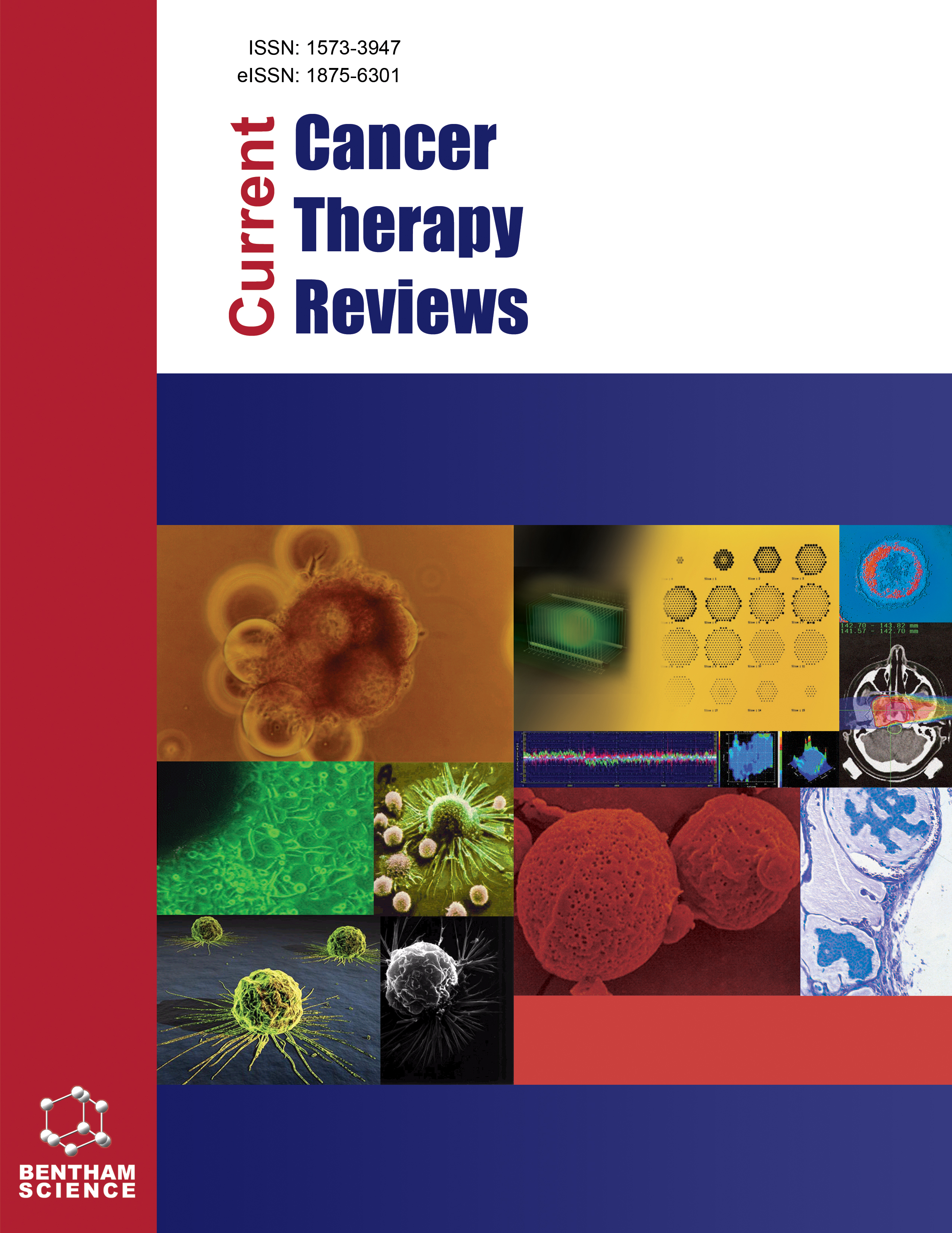- Home
- A-Z Publications
- Current Cancer Therapy Reviews
- Previous Issues
- Volume 5, Issue 2, 2009
Current Cancer Therapy Reviews - Volume 5, Issue 2, 2009
Volume 5, Issue 2, 2009
-
-
Cancer Nanotechnology - Prospects for Cancer Diagnostics and Therapy
More LessNanotechnology is a multidisciplinary field that brings together diverse fields of research and development such as engineering, biology, physics and chemistry. Formal definitions of nanotechnology refer to man-made devices, components and structures in the 1-100 nm range in at least one dimension. Advances in nanoscience are having a significant impact on many scientific fields, boosting the development of a variety of i Read More
-
-
-
Status of Flavonols as P-Glycoprotein Inhibitors in Cancer Chemotherapy
More LessAuthors: Tripta Bansal, Manu Jaggi, Roop K. Khar and Sushama TalegaonkarCancer treatment by drugs is seriously limited by P-glycoprotein (P-gp) associated multi-drug resistance (MDR) in various tumor cells. It is now widely recognized that P-gp influences drug transport across various biological membranes. P-gp transporter is widely present in various body tissues affecting absorption, distribution, metabolism and excretion of drugs. Clinical significance of above mentioned carrier is apprecia Read More
-
-
-
GIST and Breast Cancer: 3 Case Reports and a Review of the Literature
More LessAuthors: Gaia Schiavon, Robert G. Maki and Monica FornierBackground: Gastrointestinal stromal tumors (GISTs) are the most common mesenchymal tumors. Some cases of association with breast cancer have been described, but the possible etiological relationship between GIST and breast adenocarcinoma is unknown. Methods: We report on three patients with diagnoses of GIST and breast carcinoma at Memorial Sloan-Kettering Cancer Center. We review the literature regarding GI Read More
-
-
-
Cancer Stem Cells of Head and Neck Squamous Cell Carcinoma
More LessAuthors: Mathilde Lechevrel and Brigitte SolaHomeostasis of most tissues and organs is maintained by tissue-specific somatic or adult stem cells (SCs) and their early progenitors possessing two main properties: self-renewal and differentiation. To fulfil these two functions, they must undergo either symmetrical division for stem cell expansion, necessary after injury for example, or asymmetrical division for stem cell maintenance and progenitor production. The “canc Read More
-
-
-
Two Diseases with One Hit: Inhibiting a Potential Diabetes Target to Reduce Cancer Risk and to Improve Anti-Cancer Therapy
More LessObesity is a well-recognized cancer risk factor. The increase in risk for colorectal, endometrial, breast and esophageal cancers associated with obesity ranges from 1.5- to as much as 3-fold. Obese patients develop more aggressive cancers that are less responsive to treatment. Here, we review the available data on an obesity-linked gene, SH2-domaincontaining inositol 5-phosphatase-2 (SHIP2), in light of new experiment Read More
-
-
-
Apoptotic Signaling in Pancreatic Cancer - Therapeutic Application (Supplemental Data)
More LessAuthors: Felix Ruckert, Christian Pilarsky, Hans-Detlev Saeger and Robert GrutzmannPancreatic cancer is an exceptionally devastating and incurable disease, the treatment of which has largely been unsuccessful due to the higher resistance of pancreatic tumor cells to oncologic treatment. PDAC cells have accumulated different molecular mechanisms, which enable survival against cytotoxic therapies. Defects of the apoptosis pathway play a crucial role. For the last 10 years, many investigations were underw Read More
-
-
-
Dendritoma Vaccine for Cancer: A Hopeful Approach
More LessAuthors: Yanzhang Wei, Jinhua Li and Thomas E. WagnerCancer vaccines based on dendritic cells (DCs) have been among the most vigorously studied new cancer therapies during the last decade. Although DCs, the most potent antigen-presenting cells in the body, can be loaded with tumor antigens through varying approaches, such as pulsing and gene transfer, DC-tumor fusion represents the most effective way of engaging DCs with tumor antigens. A significant amoun Read More
-
-
-
Anal Carcinoma
More LessAuthors: Wayne A.I. Frederick, Neil Bhayani, Debra Ford, Gary Yang and Charles R. Thomas Jr.Anal carcinoma accounts for less than 2% of all gastrointestinal malignancies. The incidence of anal cancer is increasing and may be associated with an increase in anal receptive intercourse or higher number of sexual partners. Such behaviors have also increased the risk of infection with both HIV and human papilloma virus (HPV). HPV appears to induce dysplasia in the anal mucosa, which is readily detectable and treatabl Read More
-
Volumes & issues
-
Volume 21 (2025)
-
Volume 20 (2024)
-
Volume 19 (2023)
-
Volume 18 (2022)
-
Volume 17 (2021)
-
Volume 16 (2020)
-
Volume 15 (2019)
-
Volume 14 (2018)
-
Volume 13 (2017)
-
Volume 12 (2016)
-
Volume 11 (2015)
-
Volume 10 (2014)
-
Volume 9 (2013)
-
Volume 8 (2012)
-
Volume 7 (2011)
-
Volume 6 (2010)
-
Volume 5 (2009)
-
Volume 4 (2008)
-
Volume 3 (2007)
-
Volume 2 (2006)
-
Volume 1 (2005)
Most Read This Month
Article
content/journals/cctr
Journal
10
5
false
en


